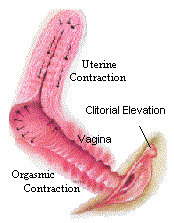

9 of 13
Female Orgasm
 Facial expression, reddish face, vocalization and nipple erection during orgasmic phase. The skin and other areas become flushed because adrenaline dilates the body's superficial blood vessels; The heart accelerates in order to pump more blood to the muscles; In the brain, the activity of neurons increase in certain areas; In the lungs, breathing becomes quicker in order to oxygenate blood, which is circulating faster. |
 Female genital apparatus during normal stage |
 Female genital apparatus during orgasmic stage |
Orgasm, also called climax, is a physiological state of heightened sexual excitement and gratification that is followed by relaxation of sexual tensions and the body's muscles. It is marked by a feeling of sudden and intense pleasure.
Orgasms benefit women physically and psychologically in many ways, from easing menstrual cramps to alleviating stress. And many men do care deeply whether their partners reach a climax. A sexual relationship that doesn't satisfy both of you won't fulfill him emotionally, no matter how much physical enjoyment he gets from the act itself.
To reach orgasm, the central nervous
system sends orders to the heart, so
that its beat frequency increases. Adrenaline, poured out by the adrenal glands, dilate
arteries, increasing blood flow to the muscles involved in sexual activities. To oxygenate
blood better, the lungs increase their work, and respiration becomes shallower and quicker.
Sweating increases, probably in order to dissipate the accumulated body heat.
Orgasm is marked by: Orgasm lasts for a few seconds
(normally not over ten); continued stimulation can produce additional orgasms
in females. In brief, after one orgasm a male becomes unresponsive to sexual
stimulation and cannot begin to build up another excitement phase until
some period of time has elapsed, but females are physically capable of
repeated orgasms without the intervening "rest period" required
by males.
![]() a feeling of sudden
intense pleasure,
a feeling of sudden
intense pleasure,
![]() an abrupt increase
in pulse rate and blood pressure,
an abrupt increase
in pulse rate and blood pressure,
![]() The breasts are
enlarged, with nipples erected;
The breasts are
enlarged, with nipples erected;
![]() Sex flush and
vasocontriction are widespread;
Sex flush and
vasocontriction are widespread;
![]() The clitoris is
completely withdrawn;
The clitoris is
completely withdrawn;
![]() The vagina is
lubrificated (see Sewelling and Lubrification in
Woman);
The vagina is
lubrificated (see Sewelling and Lubrification in
Woman);
![]() The uterus is
elevated;
The uterus is
elevated;
![]() spasms of the
pelvic muscles causing vaginal contractions in the female and ejaculation
by the male.
spasms of the
pelvic muscles causing vaginal contractions in the female and ejaculation
by the male.
![]() Involuntary vocalization
may also occur.
Involuntary vocalization
may also occur.
Female Orgasm: Why?
Female orgasm has remained a mystery compared with the more frequent and easily achieved male orgasm. In terms of evolution and adaptation, women do not need to experience orgasm in order to reproduce. So what is the function of orgasm in females?
Darwinian theorists who made early attempts to address female orgasm proposed that orgasm keeps a woman lying down after sex, passively retaining sperm and increasing her probability of conception. Others suggested that it evolved to create a stronger pair bond between lovers, inspiring in women feelings of intimacy and trust toward mates. Some reasoned that orgasm communicates a woman's sexual satisfaction and devotion to a lover.
Evolutionary psychologists have been exploring the proposition that female orgasm is a sophisticated adaptation that allows women to manipulate--even without their own awareness--which of their lovers will be allowed to fertilize their eggs (3).
It's no secret that some women have multiple orgasms--Masters and Johnson documented the phenomenon more than 20 years ago (6).
The female orgasm presents a paradox. While it is much more difficult to achieve than male orgasm, when achieved, it seems capable of repeated pleasure: the so-called multiple orgasm. Why, in any adaptational argument, should this be? Why should the female's pleasure not be as direct and as immediately rewarding as the male's?
Theories suggest that muscular contractions associated with orgasms pull sperm from the vagina to the cervix, where it's in better position to reach the egg. Reseachers discovered that when a woman climaxes until 45 minutes after her lover ejaculates, she retains significantly more sperm than she does after nonorgasmic sex (3).
Researchers at University in New Brunswick, NJ, believe they have isolated a chemical that produces orgasms in women.
Through experiments with lab rats, the researchers determined that the brain can receive signals of sexual response through a pathway other than the spinal cord. They found an alternate pathway through the vagus nerve, which goes directly from the cervix, through the abdomen and chest cavity, into the neck and to the brain stem.
Women who were paralyzed and had no feeling below the breast area were, in fact, capable of having orgasm ((7)).
Those experiments helped lead to the isolation of the vasoactive intestinal peptide, which he believes is the neurotransmitter, or nervous system chemical messenger, in the body that causes the orgasm sensation in the brain.
That same chemical may also have strong pain-suppressing qualities rivaling morphine that one day may make it a natural source of pain relief (7).
The finding could lead to a pill that would give a person the same sensation as an orgasm and might be used in treating pain.
Go to the first page of this article
Author: Dr. Silvia Helena Cardoso, PhD. Psychobiologist, master and doctor in Sciences by the University of São Paulo and post doctoral fellowship by the University of California, Los Angeles. Invited Professor and Associate Researcher of the Center for Biomedical Informatics, State University of Campinas (Unicamp), Brazil.
Center for Biomedical Informatics
State University of Campinas, Brazil
Copyright 1997 State University of Campinas